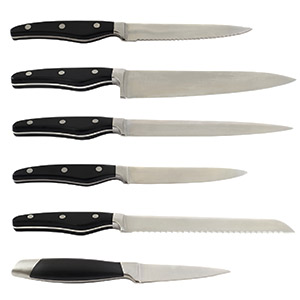
One of the basics of any kitchen is a set of knives. They don’t all have to match, but its a good idea it they are good quality and sharp.
Once you invest in good knives, you can use them for the rest of your life. My favorite and most used knives are over 30 years old and I have a couple that are older still.
You can find a lot of sets of knives, but most include knives you may rarely use. There are only a few that you really need to have and will use all the time, so these are the basic knives.
Remember to get high quality knives and keep them sharp. A sharper knife is a safer knife because, if you get cut, a clean cut will heal faster. If the knife is sharp, there is also less likelihood you will get cut. A good test of a sharp knife is that it cuts through a tomato cleanly without pressing.
The Big 3
If you are just investing in good quality knives, consider starting with these three.
The Chef’s knife

The queen of kitchen knives is the chef’s knife. The Chefs knife is known for it long, wide, curved blade. This is the knife used to chop things up and cut bigger items, like melons. I use this knife every day. If you only have one really good knife, this is the one to have. They come in many different lengths of blade, so try them out to feel what’s comfortable for you.
The Paring Knife

The paring knife is the smallest of your kitchen knives. It’s main purpose is to remove the peels from things like potatoes and so on, and also to cut small things. This is my second most used knife.
The Bread or Serrated Knife

This is called a bread knife because the serrated blade (the jagged, saw-like edge) is ideal for cutting through breads and cakes. In fact, serrated blade knives are the only ones of your kitchen knives to use on bread and pastries, or you will likely pull and tear them. Don’t use a sharpening tool on a serrated edge.
The Nice-to-Have Knives
The Carving Knife

The carving knife has a long blade which is thinner and more straight than a chef’s knife. If you have a carving knife, it’s the one to use to carve a turkey, chicken, or roast because you can make a long drawing cut which will not tear the meat and makes more attractive servings.
The Smaller Serrated Knife

Wielding a long serrated blade is not always needed for french bread, rolls, smaller cakes and so on, so its nice to have a smaller serrated knife to cut smaller baked items and for smaller hands (like children).
A Larger Paring Knife

While it’s not necessary to have 2 paring knives, I have found on more than one occasion its a good idea to have two, and one might be slightly larger than the other, though not necessarily.
Sharpening Your Kitchen Knives
Remember, practice good kitchen safety and keep your knives sharp.
You will need a tool to sharpen your non-serrated blades. I prefer a two sided sharpener to a sharpening rod. It’s just easier and quicker for me to use. Again, don’t use it on the serrated blades.
It you get in the habit of using sharp blades, you will not when they aren’t and it only takes a couple of minutes to get your kitchen knives sharp and working well again.
If you give a knife as a present (and several of mine were gifts because they are expensive), be sure to honor superstition or tradition and tape a penny to the blade so you don’t sever the friendship.
Do you have a favorite knife?

Leave a Reply